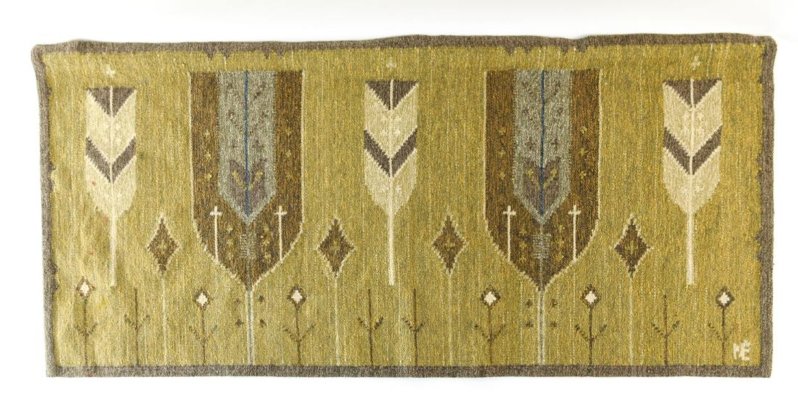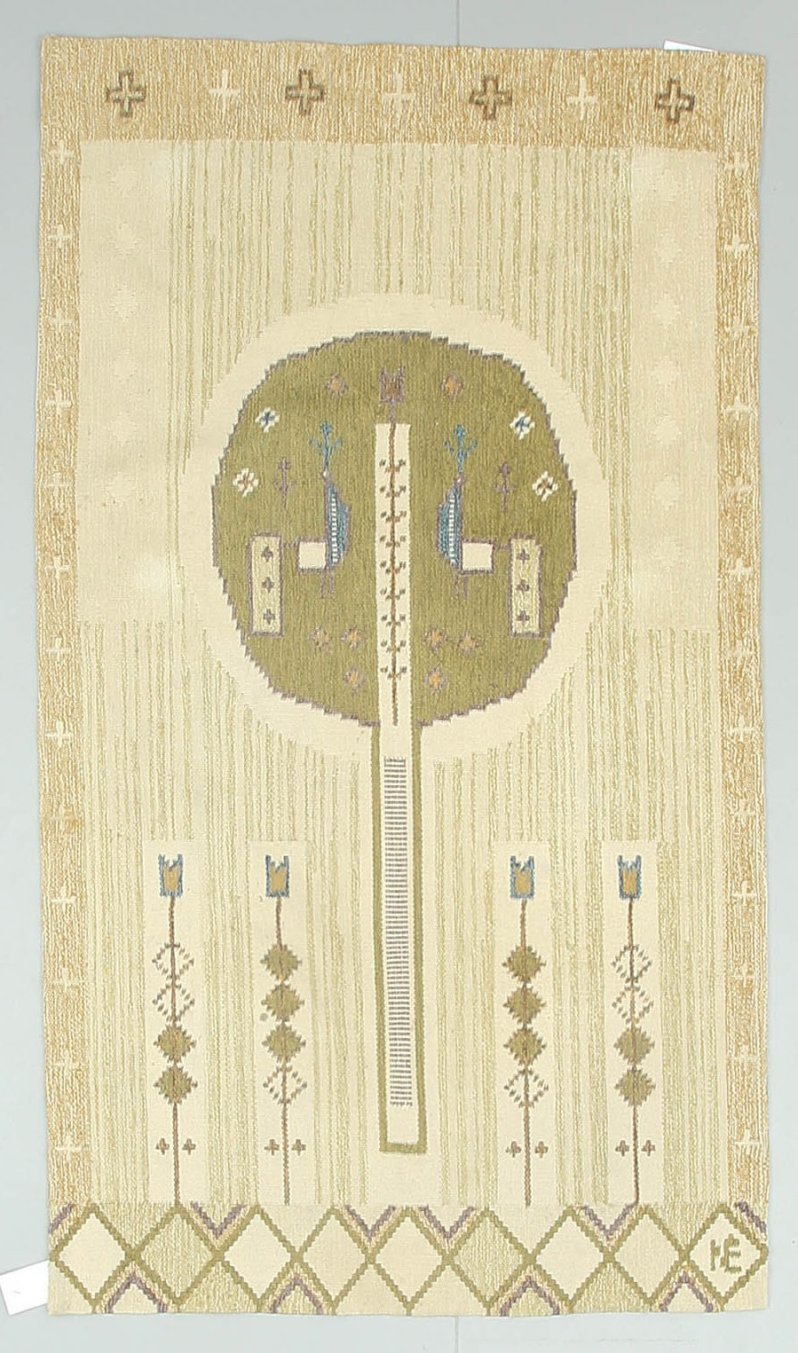Usually I write about Swedish designers whose work I know, and whom I know at least something about. This artist is different. Given the demographics of this field, the designer is likely to be a woman—I call her the Birdwoman or Ms. Birdhorse, for her main subjects. Her work is so consistent and distinctive in its imagery and colors that it seems time to find her a name.

While these are not all small pieces, they are nearly all flat-weaves (rölakan). Despite their size, they seem to have been woven as if they were tapestries—that is side to side. Thus they may have all been meant to be used as either wall hangings, or as small to medium-sized rugs. Their decorative pictoral quality and one-directional aspect also argues for their use as wall hangings.


There is no fringe on any of these pieces to indicate warp direction, but looking closely at the weave, one can see the direction of the warp consistently side to side. The nature of the patterns of these pieces which have so many vertical elements and stripes also argues for these elements being in the direction of the weft, not the warp.
The flat-woven pieces shown above have a consistent color palette, and all feature birds with tails pointing upward. Trees and flowers are all abstracted stalks. Diamond shapes seem to be tending toward becoming trees. The larger weaving below continues these visual themes and has some of the same elements, although this one explores the use of a symmetrical color-blocked background.

The following two close-up shots show the direction of the warp threads running side to side across the piece with weft threads running vertically and crossing over and under these. The second shot also shows how a curved shape is constructed incrementally with the weft.


The next rug shown, and subsequent ones, are linked by the fact that all employ a kind of
waterfall-like tail. This is the design motif that links the bird forms with the horse forms in this artist’s oeuvre.

The next piece, an anomalous rug woven in pile rather than flat weave takes the diamond shape and gives it a rounded quality—definitely a tree. It is unclear whether this design proceeded the flat-woven diamond shapes, or came after it. In fact, I have no dates for any of these pieces, so am ordering them only stylistically here.

The following pieces show this designer’s transformation of birds into horses.


Another piece with horses introduces a new element: the abstract female shape.

The largest of these pieces I have seen is shown below. Like the large weaving with the two facing blue birds shown above (fourth from the top), this one also uses a symmetrical background of colored block areas. The design of the horse elements with their waterfall tails is familiar. The new design element introduced here is that of six abstract female figures at the bottom of the piece. Interestingly, I have found two copies of this piece, with the smaller one classified as a wall-hanging by the seller. The photographs I have of these, however are disproportionate in size– the smaller photo for the larger weaving, and vice versa. But the larger photo provides us with several more close-up views of the piece.




Most of these pieces are signed clearly but with a confusing combination of letters, as we will see below. Their place of origin is equally unclear: when listed for sale, one of these was cited as being from the Bohuslöjd — that is, from a Country Craft Association near Gothenburg. (Bohuslän is located just where Sweden begins to abut Norway and is the most northern coastal province on Sweden’s west coast). Another was attributed to a Finnish designer (unnamed), and another was described as a “Danish wallhanging”. Most of these have sold in southern Sweden, proximate to both Gothenburg and Copenhagen. So there is no assurance this is even a Swedish artist— she may well be Danish.
You can see how much I don’t know here.
But what I do know, is that while not all are initialed, all are clearly from the same designer. You can just see it. Look at them yourself, and see how similar the shapes of the horses and the birds are, how flowers are all forked sticks and diamonds become trees.
There are three pieces which are unquestionably wall hangings, by their size. Two of these are two versions of the same charmingly decorative design in different colors.




We have several versions of a fairly consistent —if perplexing—signature. At first I thought these letters looked like lower case letters, and to me, the first one looks like a (somewhat flat) “r.” I read the second letter as several letters superimposed to make a very distinctive mark. In itself this is not so surprising: there are several other designers who conjoin letters (Anna-Greta Sjoqvist,for example, leans the G into the A in her rug signatures to make AG conjoined, something I can’t reproduce on the computer).


But unlike those signatures, the second element in this signature seems to contain a number of letters piled up on top of each other rather than leaning next to each other. I have never seen this kind of visual pile-up of what might be a letter “t,” a letter, “f,”, or possibly a capital E. This would give us something like “r-f-t” or “r-E-f”, although, this combination of capital and lower-case letters seems unlikely.
Let’s consider another possibility. What if there are just two letters in this signature, and the second letter helps the first letter complete its shape? Could the curve of the “r” continue on up over the top of the second letter, which still might be an “f” or a “t”? The signature below could read that way.

Or could these both be capital letters so that the vertical bar of the second letter finalizes the first— so that the wedge part of the first letter reads as the downward stroke of an N, joined to an E? While not all of the signatures we have seen are read convincingly in this way, at least two of the signatures we have seen would support this conclusion:


Ok— it’s now time for you readers, especially the Swedes and Danes among you, to bring a little crowd-sourcing into action. Have you seen other pieces by this artist? Do you know where they were purchased, or maybe even who wove them? We can ask the purchasing question a little more broadly, and include Americans this time, since I found three of these pieces offered for sale in a Berkley, California auction house (all 3 sold for $375), so some American somewhere along the line traveled to Sweden or Denmark and bought them. One would think there would be a few more pieces of this artist’s work around out there, and someone must know something!
This artist’s form vocabulary is certainly consistent, and the signature should be decipherable. Let’s see if we can find the Birdartist a name and a home!
UPDATE 8/18/18:
Another of these pieces (see image below)is currently on auction in Westport, Ct. It is listed as “Danish Kilim Tapestry,” Lot 0177. I wrote to the auctioneers for clarification and they said that they guarenteed the item to be Danish and confirmed that it had been directly imported from Denmark by long-time consignors of the auction house. We still do not know the designer’s name, but at least we can narrow the source to mid-century Denmark!

FURTHER UPDATE 10/9/19:
Looking through back listings of Bukowski’s Auction house, Stockholm, I found confirmation that these were made by a Danish company, named Ziola. Who the designer was for that company, I still don’t know. The following two photographs, front and back, are of a piece, clearly by the designer identified in this blog post– and now known to be by this company, with a tag attached to the back. Unfortunately there are no close up views of the tag, but the listing for the piece identifed it as Danish. Hopefully another one of these with a readable tag will show up!


Sources:
Bukowskis (online) Auction House Stockholm
Clars Auction gallery, Berkley Ca Dec 13, 2015 Fine Art and Antiques Auction, lot 2413
firstdibs.com
Freedom Auction House, Sarasota, Florida
Garpenhus Auktioner, Malmö, Sweden via auctionenet.com
Joshua Lumley Ltd., Egerton, Great Britain via first dibs; item reference Number
LU250136765003
Leiflers Auktionshus, Falköping, Sweden via auctionet.com
Westport Auctions via Live Auctioneers; email conversation 8/15/18
Anne, these are such beautiful tapestries! Thank you for tracking down the stream of this weaver’s work and presenting them all here. I love seeing the evolution of the themes and images. I wonder if the bird – horse relates to any images in Norse mythology? I’ll check with my resident expert in that area and let you know. Other readers may know more.
LikeLike
Thanks, Robbin! I’m glad you are liking them. Just since I published this blog, I have found 5 more examples out there, so I’m sure someone must know something about where the pieces were bought and when.
LikeLike
Nov 12, 2018 –I received this note by email, and am thrilled and grateful to Eva to have identifed this artist, whose work was apparently marketed in Denmark during the 1970s-80s.
Dear Anne,
your Birdwoman is a Hungarian designer Eva Nemeth (NE).
https://nemetheva.com/Biography
https://nemetheva.com/
Kind regards
Eva from Germany, who also loves the art of Nemeth Eva
LikeLike
Dear Anne,
I am seconding Eva’s suggestion. The artist is Eva Nemeth. Much of her work was marketed in Denmark.
Agnes
LikeLike
Dear Agnes,
I think that you will see I wrote a final post on this topic crediting Eva from Germany with solving the mystery. Thanks for your second!
Best, Anne
LikeLike
Hi Anne,
I just bought one of these wall weavings and was trying to track down the artist. The one I have has a long fringe, which is so different from what I’ve found online; however has the same signature. I’m really glad I came upon your blog, as I was told from the vintage gallery that it was Cepelia of Poland. I originally thought it was Evelyn Ackerman- maiden name Lipton. She did a lot of midcentury bird designs with this style.
Thanks again!
Courtney
LikeLike
Hi Courtney,
So glad you found your answer (here!)
You can see that it tok me a while to get there too. But I’m glad you have your piece and can enjoy knowing what it is. The blog has another piece on Polish rugs misidentified as Swedish as well, in April 2018. And hopefully, you’ll enjoy learning about the Swedish work too!
Best, Anne
LikeLike
Hi, I’m glad to se my mothers carpets above. See more here: nemetheva.com If anybody needs more information please contact me: design@gaborpalotai.com / gaborpalotai.com / Best wishes, Gabor Palotai
LikeLike
Hi! Greetings from Tanzania. I just bought a piece here, at the foot of Mount Kilimanjaro, and Google Lens brought me to you. The identical piece with horses that I now have, appears in your blog. Wonderful to know the Nordic roots.
LikeLike